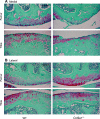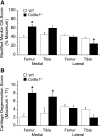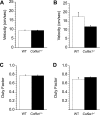Locomotor activity and gait in aged mice deficient for type IX collagen
- PMID: 20360435
- PMCID: PMC2904201
- DOI: 10.1152/japplphysiol.00056.2010
Locomotor activity and gait in aged mice deficient for type IX collagen
Abstract
Osteoarthritis (OA) is a risk factor for physical inactivity and impaired mobility, but it is not well understood how these locomotor behaviors are affected by the age of onset of OA and disease severity. Male mice homozygous for a Col9a1 gene inactivation (Col9a1(-/-)) develop early onset knee OA, increased tactile pain sensitivity, and gait alterations by 9 mo of age. We hypothesized that aged Col9a1(-/-) mice would reduce joint pain by adopting locomotor behaviors that reduce both the magnitude and daily frequency of joint loading. We tested this hypothesis by evaluating gait and spontaneous locomotor activity in 15- to 17-mo-old male Col9a1(-/-) (n = 5) and Col9a1(+/+)(WT) (n = 5) mice using well-controlled measures of voluntary activity in overground and running wheel conditions, as well as studies of gait in a velocity-controlled treadmill. We found no difference due to genotype in freely chosen locomotor velocity, stride frequency, hindfoot duty factor, dark phase activity time, or dark-phase travel distance during overground, running wheel, or speed-matched treadmill locomotion. Interpretation of these findings is potentially confounded by the observation that WT mice have greater knee OA than Col9a1(-/-) mice in the lateral tibial plateau by 17 mo of age. When accounting for individual differences in knee OA, functional locomotor impairments in aged Col9a1(-/-) and WT mice are manifested as reductions in total locomotor activity levels (e.g., both distance traveled and time active), particularly for wheel running. These results support the concept that current disease status, rather than age of disease onset, is the primary determinant of impaired locomotor activity with aging.
Figures





Similar articles
-
Decreased physical function and increased pain sensitivity in mice deficient for type IX collagen.Arthritis Rheum. 2009 Sep;60(9):2684-93. doi: 10.1002/art.24783. Arthritis Rheum. 2009. PMID: 19714629 Free PMC article.
-
Pathogenesis of osteoarthritis-like changes in the joints of mice deficient in type IX collagen.Arthritis Rheum. 2006 Sep;54(9):2891-900. doi: 10.1002/art.22040. Arthritis Rheum. 2006. PMID: 16947423
-
Selective Breeding and Short-Term Access to a Running Wheel Alter Stride Characteristics in House Mice.Physiol Biochem Zool. 2017 Sep/Oct;90(5):533-545. doi: 10.1086/692909. Physiol Biochem Zool. 2017. PMID: 28636434
-
Effect of Footwear on Joint Pain and Function in Older Adults With Lower Extremity Osteoarthritis.J Geriatr Phys Ther. 2018 Apr/Jun;41(2):85-101. doi: 10.1519/JPT.0000000000000108. J Geriatr Phys Ther. 2018. PMID: 27824657
-
The Relationship Between Changes in Movement and Activity Limitation or Pain in People With Knee Osteoarthritis: A Systematic Review.J Orthop Sports Phys Ther. 2021 Oct;51(10):492-502. doi: 10.2519/jospt.2021.10418. J Orthop Sports Phys Ther. 2021. PMID: 34592828
Cited by
-
Diet-induced obesity significantly increases the severity of posttraumatic arthritis in mice.Arthritis Rheum. 2012 Oct;64(10):3220-30. doi: 10.1002/art.34533. Arthritis Rheum. 2012. PMID: 22576842 Free PMC article.
-
Animal models of osteoarthritis: classification, update, and measurement of outcomes.J Orthop Surg Res. 2016 Feb 2;11:19. doi: 10.1186/s13018-016-0346-5. J Orthop Surg Res. 2016. PMID: 26837951 Free PMC article. Review.
-
Modifications of gait as predictors of natural osteoarthritis progression in STR/Ort mice.Arthritis Rheumatol. 2014 Jul;66(7):1832-42. doi: 10.1002/art.38616. Arthritis Rheumatol. 2014. PMID: 24623711 Free PMC article.
-
Osteoking Decelerates Cartilage Degeneration in DMM-Induced Osteoarthritic Mice Model Through TGF-β/smad-dependent Manner.Front Pharmacol. 2021 Jun 15;12:678810. doi: 10.3389/fphar.2021.678810. eCollection 2021. Front Pharmacol. 2021. PMID: 34211396 Free PMC article.
-
Factors affecting the reliability of behavioral assessments for rodent osteoarthritis models.Lab Anim. 2020 Aug;54(4):317-329. doi: 10.1177/0023677219867715. Epub 2019 Aug 20. Lab Anim. 2020. PMID: 31431137 Free PMC article. Review.
References
-
- Akimoto T, Ribar TJ, Williams RS, Yan Z. Skeletal muscle adaptation in response to voluntary running in Ca2+/calmodulin-dependent protein kinase IV-deficient mice. Am J Physiol Cell Physiol 287: C1311– C1319, 2004 - PubMed
-
- Al-Zahrani KS, Bakheit AM. A study of the gait characteristics of patients with chronic osteoarthritis of the knee. Disabil Rehabil 24: 275– 280, 2002 - PubMed
-
- Alexander RM, Jayes AS. Fourier analysis of forces exerted in walking and running. J Biomech 13: 383– 390, 1980 - PubMed
-
- Allen DL, Harrison BC, Maass A, Bell ML, Byrnes WC, Leinwand LA. Cardiac and skeletal muscle adaptations to voluntary wheel running in the mouse. J Appl Physiol 90: 1900– 1908, 2001 - PubMed
Publication types
MeSH terms
Substances
Grants and funding
LinkOut - more resources
Full Text Sources
Medical
Molecular Biology Databases

